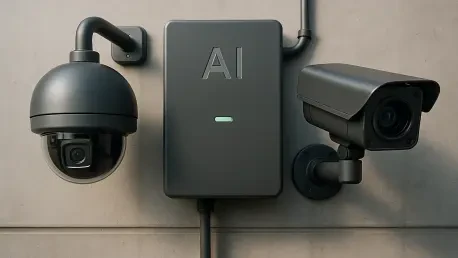In an era where technology shapes every facet of daily life, artificial intelligence has emerged as a game-changer in the realm of security, moving beyond simply reacting to incidents and instead anticipating and preventing them before they occur. This shift echoes the haunting vision of “Minority Report,” a film that depicted a future where pre-emptive justice ruled through foresight. Now, AI-driven systems are turning such fiction into reality, leveraging sophisticated algorithms to detect threats in both physical environments and digital landscapes. From surveillance cameras that flag unusual behavior to cybersecurity tools that neutralize risks in milliseconds, the promise of enhanced safety is undeniable. However, this technological leap brings with it a profound ethical quandary: how does society balance the benefits of predictive security with the potential erosion of personal freedoms? The concept of pre-crime—stopping wrongdoing before it happens—may sound like an ideal solution for law enforcement and safety professionals, but it raises troubling questions about fairness, privacy, and the risk of innocent individuals being unjustly targeted. As AI continues to redefine security, the stakes grow higher, demanding a closer look at both its capabilities and its consequences.
Technological Breakthroughs in AI Security
Understanding AI’s Predictive Power
The foundation of modern AI security systems lies in their ability to shift from reactive measures to proactive threat prevention, a transformation driven by cutting-edge algorithms and powerful hardware. Deep learning models, such as convolutional neural networks, excel at analyzing surveillance footage to detect suspicious activities with remarkable precision, far surpassing the capabilities of traditional CCTV setups. Meanwhile, in the digital realm, platforms powered by natural language processing and reinforcement learning can identify and mitigate cyber threats before they escalate into full-blown attacks. These tools rely on real-time data processing, supported by advanced hardware like specialized processing units, to minimize delays and reduce false positives. The result is a security landscape where potential dangers are flagged and addressed with unprecedented speed, offering a level of efficiency that older systems could never match. This technological prowess is already reshaping how organizations and governments approach safety, setting a new standard for what proactive defense can achieve.
Beyond the algorithms and hardware, the integration of AI into security operations introduces a level of automation that streamlines complex tasks and frees up human resources for strategic oversight. For instance, security orchestration and response platforms use AI to coordinate responses across multiple systems, ensuring that threats are contained swiftly without overwhelming personnel. Similarly, anomaly detection models analyze patterns in vast datasets—whether from video feeds or network traffic—to spot irregularities that might signal an impending issue. This predictive capability not only enhances accuracy but also builds a more adaptive defense mechanism, capable of evolving alongside emerging threats. While traditional methods often lagged in response time, AI’s ability to learn and adjust in real time marks a significant leap forward. However, the sophistication of these systems also underscores the need for rigorous testing and validation to ensure they operate as intended, without introducing unforeseen risks or errors.
Exploring the Mechanics of Threat Detection
Delving deeper into the mechanics, AI security systems harness a variety of specialized models to tackle specific challenges, each contributing to a broader ecosystem of threat detection. In physical security, behavioral analytics powered by recurrent neural networks can track patterns over time, identifying deviations that might indicate malicious intent, such as unusual crowd movements in public spaces. On the cybersecurity front, extended detection and response frameworks integrate AI to correlate data across endpoints, networks, and cloud environments, creating a comprehensive shield against sophisticated attacks. These systems are designed to minimize human intervention, automating routine monitoring and response tasks with a precision that manual processes struggle to match. The reduction in false alarms alone represents a major advancement, as it allows security teams to focus on genuine threats rather than sifting through irrelevant alerts, thereby optimizing resource allocation.
Equally critical to this ecosystem is the role of hardware in enabling AI’s predictive power, particularly in environments where split-second decisions are paramount. Edge computing, supported by neural processing units, brings data analysis closer to the source—whether a surveillance camera or a network gateway—reducing latency and ensuring near-instantaneous responses. This capability is vital in high-stakes scenarios, such as identifying a potential intruder or blocking a ransomware attack mid-progression. Furthermore, the continuous learning aspect of AI means that these systems improve over time, refining their accuracy as they process more data. Yet, this reliance on constant data input also highlights a vulnerability: the quality and integrity of that data must be impeccable to avoid skewed predictions. As these technologies become more embedded in security frameworks, ensuring robust data governance emerges as a key priority to maintain trust and reliability.
Market Forces and Innovation
The Race for AI Dominance
The market for AI-driven security solutions is experiencing explosive growth, with projections estimating a leap from billions to over a hundred billion dollars by 2030, reflecting the high stakes and fierce competition within the industry. Tech giants like Microsoft and Cisco are pouring resources into integrating AI into their platforms, often through strategic acquisitions of promising startups that bring fresh innovations to the table. These larger corporations are developing comprehensive, autonomous systems that aim to outpace traditional, rule-based security methods, offering solutions that can think and act independently. Meanwhile, smaller players like niche cybersecurity firms contribute specialized tools, often becoming targets for acquisition as bigger companies seek to bolster their portfolios. This dynamic creates a vibrant, if cutthroat, ecosystem where innovation is both a driver and a survival tactic, pushing the boundaries of what security technology can achieve.
What sets this market apart is the dual nature of AI as both a protective mechanism and a potential weapon, a reality that fuels an ongoing technological arms race. As companies race to build smarter defenses, they must also develop safeguards against AI itself being exploited—think prompt injection attacks or data poisoning that could turn a system against its own users. The shift toward AI-native platforms, which integrate disparate tools into cohesive, intelligent ecosystems, is disrupting vendors stuck on outdated models, rendering static systems obsolete in the face of adaptive threats. This trend underscores a broader truth: adaptability is no longer optional but essential. With billions of dollars on the line, the pressure to innovate is relentless, yet it also raises questions about whether market-driven speed might outpace the development of necessary ethical guidelines, leaving gaps that could be exploited.
Investment Trends and Strategic Shifts
Investment in AI security is not just about financial capital but also about strategic positioning, as companies vie for dominance in a landscape where technological superiority translates to market share. Venture capital flows heavily into startups focusing on niche areas like securing AI models themselves, recognizing that protecting the technology from misuse is as critical as deploying it for defense. Meanwhile, established firms are reallocating budgets to prioritize research and development, aiming to embed AI deeper into their core offerings. This shift is evident in the rise of platforms that promise end-to-end security solutions, from threat prediction to automated response, reducing reliance on human intervention. The economic implications are staggering, as success in this arena not only drives revenue but also shapes global standards for how security is implemented across industries.
Another layer to this market evolution is the growing emphasis on collaboration between public and private sectors, spurred by the recognition that no single entity can tackle AI security challenges alone. Governments are increasingly partnering with tech companies to deploy AI systems for national defense and public safety, often providing funding or regulatory incentives to accelerate development. However, this convergence also introduces complexities, as differing priorities—profit versus public good—can lead to friction. The competitive landscape is further complicated by the global nature of the market, where regional players must navigate varying regulations and cultural attitudes toward surveillance and data privacy. As investment continues to pour in, the trajectory of AI security will likely hinge on how well these strategic alliances balance innovation with accountability, ensuring that economic gains do not come at the expense of societal trust.
Societal and Ethical Challenges
Privacy Under Threat
The societal implications of AI security systems are as profound as their technological advancements, with privacy emerging as a central concern in an age of pervasive monitoring. Facial recognition tools, behavioral analytics, and data aggregation from sources like social media or IoT devices enable constant surveillance, often without individuals’ explicit consent. This omnipresent watchfulness risks creating a chilling effect, where people alter their behavior out of fear of being observed or misinterpreted by an algorithm. Public spaces, once realms of relative anonymity, now feel like stages under scrutiny, as cameras and sensors track movements and interactions in real time. The erosion of personal space is not just a theoretical worry but a tangible shift, prompting debates about where the line should be drawn between safety and the right to privacy, and whether such trade-offs are justified in the name of security.
Compounding this issue is the sheer scale of data collection required to fuel AI’s predictive capabilities, raising questions about who controls this information and how it is used. Personal details, from daily routines to online habits, are harvested and analyzed, often stored in databases vulnerable to breaches or misuse. Even when data is anonymized, advanced AI can sometimes re-identify individuals, undermining safeguards meant to protect anonymity. The potential for this data to be repurposed—whether by governments for social control or by private entities for profit—adds another layer of concern. As these systems become more integrated into everyday life, from smart cities to workplace monitoring, the tension between enhanced security and personal autonomy intensifies, demanding transparent policies to ensure that individual rights are not sacrificed under the guise of collective safety.
Bias and Accountability Issues
Beyond privacy, the ethical challenges of AI security systems include the risk of algorithmic bias, a problem rooted in the data used to train these technologies. When historical datasets reflect societal inequities—such as over-policing in certain communities—AI can perpetuate these biases, leading to disproportionate targeting of marginalized groups. A predictive model might flag someone as a threat based on flawed patterns rather than actual behavior, resulting in unfair scrutiny or worse. The consequences of such errors are not trivial; a false positive could lead to wrongful detentions or other life-altering outcomes, particularly when systems operate without human oversight. Addressing this requires not just better data but a fundamental rethinking of how fairness is embedded into AI design, ensuring that technology serves justice rather than undermines it.
Equally troubling is the lack of transparency in many AI systems, often described as “black boxes” due to their opaque decision-making processes. When a prediction or action is made, it can be nearly impossible to discern why or how the system arrived at that conclusion, complicating efforts to hold anyone accountable for mistakes. This opacity poses a significant barrier to trust, especially in high-stakes contexts like law enforcement or border security, where decisions carry profound consequences. Without clear explanations, affected individuals have little recourse to challenge or appeal outcomes, eroding the principles of due process. Tackling this issue necessitates developing explainable AI frameworks that demystify decision pathways, alongside stricter standards for accountability to ensure that errors or biases are identified and corrected before they cause harm.
Future Horizons and Dilemmas
Visions of Autonomous Security
Looking to the horizon, the future of AI security holds immense potential, with innovations poised to push the boundaries of what autonomous systems can achieve over the next decade. Self-healing networks, capable of detecting and repairing vulnerabilities without human input, could revolutionize cybersecurity by creating defenses that adapt in real time to new threats. Similarly, drone mesh surveillance systems might patrol urban areas, using AI to coordinate and respond to incidents with minimal latency. These advancements promise a world where safety is not just reactive or predictive but inherently self-sustaining, reducing human workload and error. Yet, the very autonomy that makes these systems appealing also raises significant challenges, as relinquishing control to machines introduces risks of malfunction or misuse that could have widespread repercussions.
The trajectory of these technologies also points to an “Internet of Agents,” where interconnected AI entities manage critical infrastructure, from power grids to transportation hubs, ensuring seamless protection against both physical and digital threats. Such a vision, while ambitious, hinges on overcoming technical hurdles like integrating with legacy systems and securing vast, high-quality datasets to train these agents effectively. Moreover, the prospect of fully autonomous security systems amplifies ethical concerns, as the absence of human judgment in critical decisions could lead to unintended escalations or oversights. As these innovations move from concept to reality, the focus must remain on building robust fail-safes and oversight mechanisms to ensure that autonomy enhances rather than undermines security objectives.
Balancing Act: Safety vs. Freedom
The tension between achieving enhanced safety and preserving personal freedoms remains at the heart of the pre-crime paradox, a dilemma that will only grow more complex as AI security systems evolve. On one hand, the ability to prevent harm before it occurs is a compelling argument for expanding these technologies, particularly in high-risk areas like terrorism or cybercrime. On the other hand, the specter of mass surveillance and predictive policing risks creating a society where everyone is treated as a potential suspect, stifling individual liberty and expression. This balance is not merely theoretical but a pressing policy challenge, requiring frameworks that define acceptable limits to AI’s reach while ensuring that safety measures do not disproportionately burden certain communities or demographics.
Navigating this delicate equilibrium demands global cooperation among industry leaders, policymakers, and civil society to establish ethical standards and regulatory guardrails that keep pace with technological progress. Transparency must be prioritized, ensuring that AI systems are not only effective but also accountable to those they impact. Additionally, public dialogue about the trade-offs involved—safety versus autonomy—should inform how these tools are deployed, preventing a slide into dystopian overreach. As history has shown with other transformative technologies, the choices made in these early stages will shape societal norms for decades. Reflecting on past debates over data privacy and surveillance, it becomes clear that proactive collaboration was key to mitigating risks, and the same urgency applied then must guide the path forward for AI security today.









